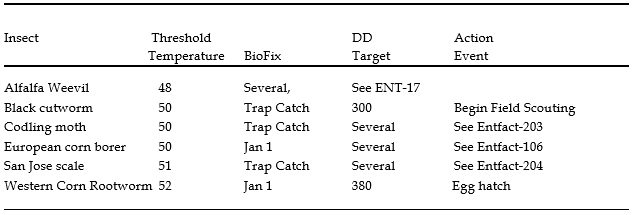Predicting Insect Development Using Degree Days
ENTFACT-123: Predicting Insect Development Using Degree Days | Download PDF
by Ric Bessin and Raul Villanueva, Extension Specialists
University of Kentucky College of Agriculture
Since insects are cold-blooded animals, temperature plays a major role in their growth and development. There is a threshold temperature for each insect; for example, 48o F for the alfalfa weevil. No development occurs when temperatures are below that level. Insects have an optimum temperature range in which they will grow rapidly. Then, there is maximum temperature (termed upper cutoff) above which development stops. These values are used to predicting insect activity and appearance of symptoms during the growing season.
The threshold and maximum temperatures for development of an insect are used to calculate the number of degree days on a specific day. One degree day results when the average temperature for a day is one degree over the threshold temperature. With the alfalfa weevil (48oF threshold temperature), on a day when the average temperature was 49oF, one degree day accumulated. These daily accumulations accumulate over a time and used to predicting insect development. In terms of field use, producers should check for the first signs of tip feeding when 190 degree days have accumulated starting from January 1.
Accumulation of degree day totals usually begins in one of two ways. It is common to start keeping track of degree days for many pests on a calendar date ( January 1 for many). While this is simple, there is the disadvantage of having to keep up with temperatures long before any insect development will occur. The second method, used for other pests, starts from a specific biological event called a biofix. Often, this is the date of the first capture of an adult in a trap (See Entfact-112). Use of a biofix starting point means keeping up with degree days over a shorter period of time and often provides a more accurate prediction.
With integrated pest management (IPM), degree day accumulations are used to predict important events in the life of an insect. Examples include egg laying, egg hatch, scale crawler movement, or appearance of symptoms. These biological events are in turn used to schedule particular activities such as scouting or timing of insecticide sprays. Threshold temperatures, biofixes, target degree day accumulations, and resulting events for several common and important insect pests in Kentucky are given in Table 1.
The easiest way to calculate degree days for a specific date is to add the daily high and low temperature and divide by two. Then, subtract the each day is to subtract threshold temperature for the particular insect. For example, if the min/max thermometer indicates a low of 45°F and a high of 75°F, then the average temperature for the day was (45+75)/2 = 60°F. If the threshold temperature was 50°F, then 10 degree days would have accumulated. Check your thermometer and make this calculation each day. Add the daily value to the total from all the previous days. You can keep up with the progress toward your target number. Record minimum and maximum temperatures from a Min/Max thermometer about the same time each day, preferably in the mid-morning or late afternoon.
The College of Agriculture Ag Weather home page maintains a continuously running system that calculates degree days for several pests at locations across the state. You can use it through the Internet at http://wwwagwx.ca.uky.edu. When you find the home page, look under ‘Lists of items on UKAWC Weather Web’ then find ‘Insect Degree Days Accumulation / Forecast’. This listing will give you current DD accumulations for several insects at 28 weather stations across Kentucky. Also look under ‘Ag Weather Center Model Calculators’ for ‘Insect Degree Days’. This will allow you to view current degree-days accumulations and predictions, using current and historic weather data for any one of 28 weather stations.
Either method will allow you to become more accurate in your pest management. This in turn can result in reductions in pesticide use and improved control through more accurate timing when pesticides are required.
References
- ENT-17. Townsend, L. Insecticide
- Recommendations for Alfalfa, Clover and Pastures.
- Entfact 106. Bessin, R. Predicting European corn borer development.
- Entfact-112. Johnson, D. Using Pheromone Traps in Field Crops
- Entfact-203. Bessin, R. Codling Moth.
Table 1. Some common insects for which Degree Days are used management.

Revised: 11/19
CAUTION! Pesticide recommendations in this publication are registered for use in Kentucky, USA ONLY! The use of some products may not be legal in your state or country. Please check with your local county agent or regulatory official before using any pesticide mentioned in this publication.
Of course, ALWAYS READ AND FOLLOW LABEL DIRECTIONS FOR SAFE USE OF ANY PESTICIDE!
Photos:University of Kentucky Entomology
